Thien Mu Pagoda, Vietnam's Timeless Spiritual Jewel
Nestled gracefully on the banks of the Perfume River in Hue, Vietnam, Thien Mu Pagoda stands as a testament to the country's rich spiritual and architectural heritage. Known for its serene beauty and historical significance, this pagoda has enchanted visitors for centuries.
Thien Mu Pagoda's History
Thien Mu Pagoda, also known as Linh Mu Pagoda, has a storied past dating back to the early 17th century. Legend has it that Lord Nguyen Hoang, upon hearing a local prophecy, ordered the construction of the pagoda to fulfill the prophecy's vision of a "Celestial Lady" (Thien Mu). Over the centuries, it has served as a spiritual center for Buddhist monks and a place of refuge during turbulent times in Vietnamese history, including wars and conflicts.
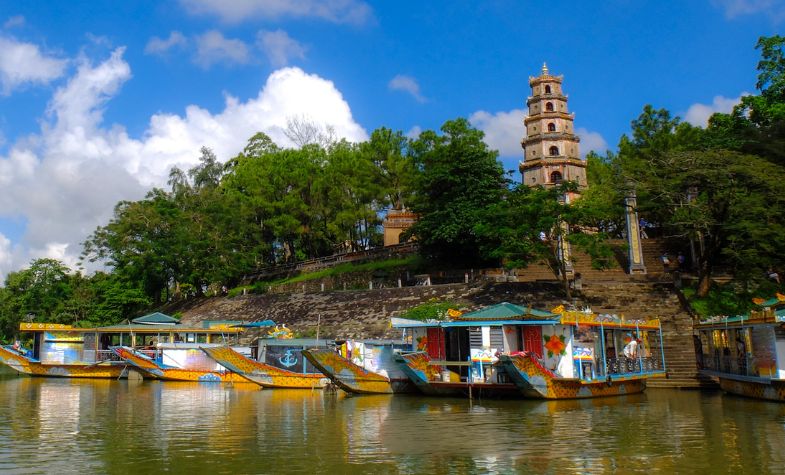
Thien Mu Pagoda's Architecture
Phuoc Duyen Tower
Phuoc Duyen Tower is a must-visit landmark when exploring Thien Mu Pagoda in Hue. This structure is situated just after the entrance gate area. Though it stands in the forefront, Phuoc Duyen Tower is often likened to the "soul" of the pagoda. Its architecture, along with other structures, forms a cohesive and uniquely Hue-style complex.
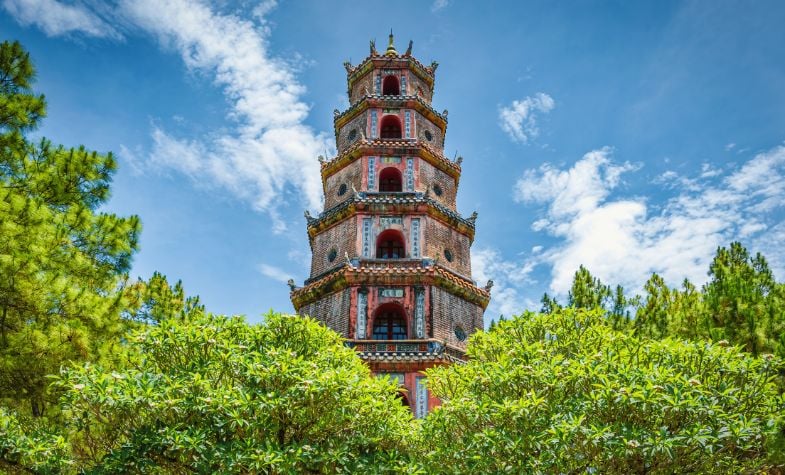
Built-in 1844 by King Thieu Tri, originally named Tu Nhan Tower, it was later renamed Phuoc Duyen Tower. At that time, materials like clay, stone, and Bat Trang ceramics were brought in from outside to complete the tower. The lower part of the tower is constructed with bricks, and the upper part with blue stone. It has a polygonal shape, narrowing as it ascends through its seven floors, each 2 meters high. Generally, the design of each floor is identical, painted in pink. Over the years, it has acquired a weathered patina, adding to its distinctive value as a symbol of the ancient capital's architecture.
Dai Hung Palace
Located within the main hall of Thien Mu Pagoda in Hue, Dai Hung Palace is dedicated to worshiping Maitreya Buddha, the deity symbolizing boundless joy. The statue of Maitreya Buddha is depicted as gentle, with large ears symbolizing deep listening, a big belly representing generosity, and a compassionate smile. The palace is constructed entirely from special cement and painted to resemble wood, providing a warm and familiar atmosphere.
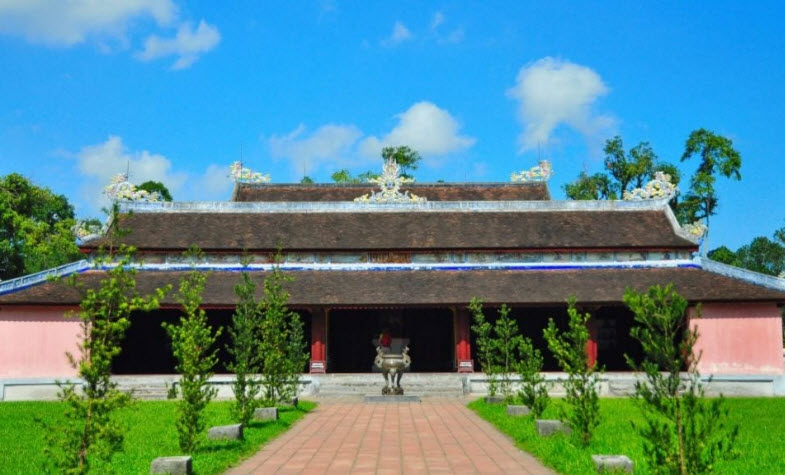
Not only does Dai Hung Palace house the statue of Maitreya Buddha, but it also preserves a large self-portrait dating back to 1974 and an exquisitely crafted bronze bell in the shape of a crescent moon. Inside, there is a shrine featuring the Three Jewels Buddha at its center, with Van Phu Bodhisattva on the left and Bodhisattva of Compassion on the right. Of special note, the area deep within Dai Hung Palace grounds serves as the final resting place of Venerable Thich Don Hau, the former abbot of the pagoda.
The Tomb of the Late Venerable Thich Don Hau
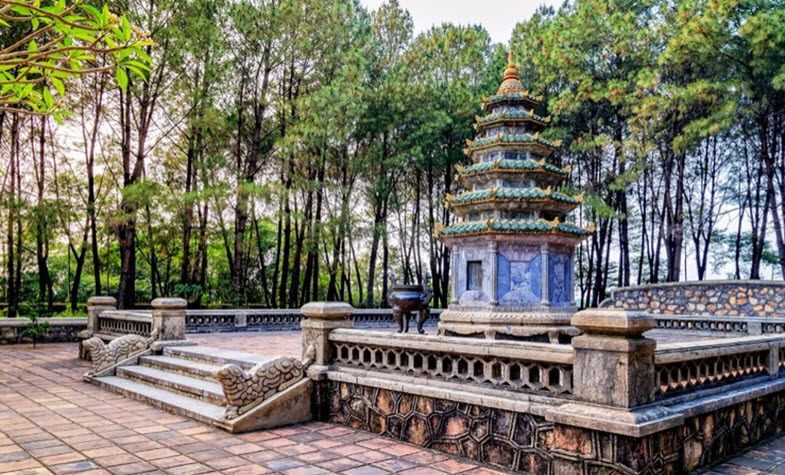
Located within the pagoda's grounds is the tomb of Thich Don Hau, a former abbot known for his contributions to Buddhism and his efforts in promoting education and charity.
Venerable Thich Don Hau was a renowned abbot at Thien Mu Pagoda in Hue. He dedicated his entire life to the development of Buddhism in Vietnam. Additionally, he earned respect from people for his numerous charitable activities and efforts to help others. Upon his passing, the local community and temple administration buried Venerable Thich Don Hau under a stupa at the end of the pagoda's grounds to express gratitude and reverence for their beloved monk.
Ksitigarbha Temple
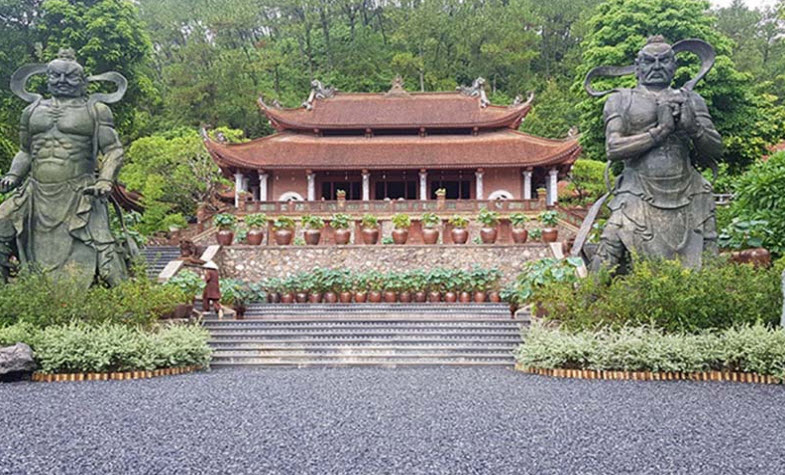
This structure is located right behind the Dai Hung Palace. The scenery here offers you peace and tranquility. In front of it is a large courtyard with green grass, trees, and a cool blue lake. Surely, this will be a delightful stop on your exploration of Thien Mu Pagoda in Hue that you shouldn't miss.
Three-Door Gate
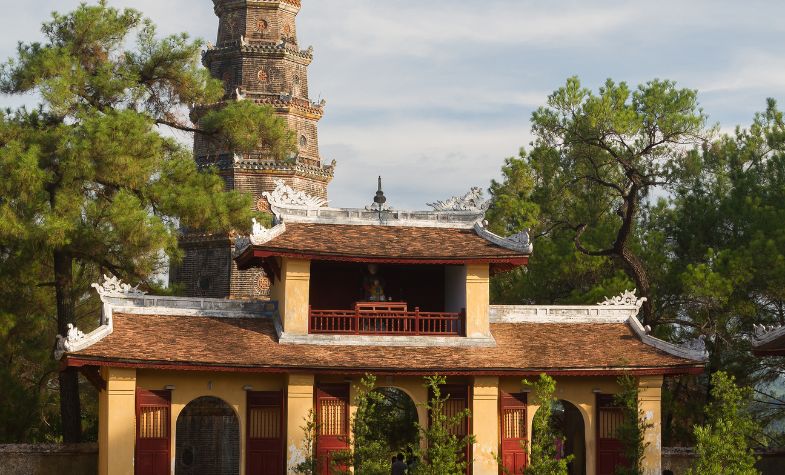
The entrance to Thien Mu Pagoda is marked by the Three-Door Gate, an ornate structure adorned with intricate motifs and guardians, symbolizing protection and spiritual passage.
This is the main entrance and exit of the pagoda, located behind the Phuoc Duyen Tower. The gate has 3 entrances, symbolizing the three realms: Human - Demon - God. It is designed with 2 floors and 8 roofs. On the second floor of the central gate, there is a Buddha altar. The roofs are decorated with intricate floral patterns. The sides of the entrances are guarded by Dvarapala statues.
Thien Mu Pagoda Opening Hours and Entrance Fee
Thien Mu Pagoda welcomes visitors daily from 8:00 AM to 5:00 PM. The entrance fee is free, reflecting its status as a place of worship and cultural significance. Visitors are encouraged to dress modestly and respectfully while exploring the pagoda grounds.
Notes When Visiting Thien Mu Pagoda
When planning your visit to Thien Mu Pagoda, consider the following tips:
-
Respectful Attire: Dress modestly, covering shoulders and knees, as a sign of respect for the religious site.
-
Footwear: Remove shoes before entering temple buildings.
-
Photography: While photography is allowed in most areas, be mindful of signs indicating restricted areas.
-
Silence and Respect: Maintain a quiet and respectful demeanor, especially during prayer times.
Thien Mu Pagoda continues to be a beacon of spiritual solace and cultural pride in Vietnam. Whether you are drawn by its historical significance, architectural beauty, or spiritual tranquility, a visit to Thien Mu Pagoda promises an enriching experience that resonates long after you leave its hallowed grounds.
Our tours you may like:
***
Travel Authentic Asia Company is your best choice for discovering the beauty of Southeast Asia. Our experienced and knowledgeable travel advisors are committed to helping you create a tailor-made tour and extraordinary experiences in this majestic region.
If you're looking for an authentic cultural experience, do not hesitate to contact Travel Authentic Asia to choose a Vietnam tour, Southeast Asia tour package or to customize your own style tour to South East Asia.

